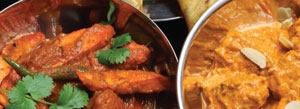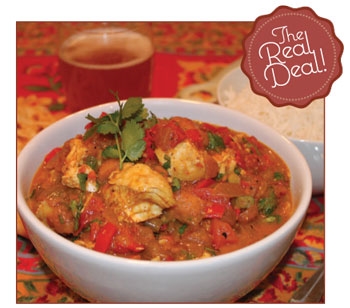Embark on a culinary journey. Get “curried” away by the flavours of India!
Words by Tonia Wilson
Indian cuisine is a very complex and varied one, with many of its most beloved dishes vastly different from each other. It’s a cuisine that evolved over thousands of years and has been deeply influenced by geography, history, religion, European colonization, and food availability.
India is a large country which borders many other countries, all of which have influenced the cooking that takes place in those areas. Climate and proximity to water are other key factors in the food products of a region; some may be based primarily on the use of fish, while others may use only lamb or chicken. Over the years the availability of vegetables, rice, and legumes dictated how recipes developed. For example, in the southwest the climate is more tropical which allows for the growth of coconuts, hence an elevated use of coconut milk in their dishes; in the northern regions it is rarely used.
Vegetarianism also plays a very large role in the diets of many Indians, and fortunately the country’s climate is ideal for the cultivation of thousands of types of vegetables, fruits, rice, lentils, and beans.
Last but not least is the preparation of regional dishes. The method in which recipes are prepared can vary greatly as well; the stove is a modern invention so the celebrated recipes of India would have been created long before electricity and four-burners. Some areas rely heavily on grilling, while others may see most dishes being made by simmering in a large pot. Of course, the most famous Indian cooking vessel is the tandoor oven, an extremely hot clay oven used to cook various meats and breads. The charcoal fire inside gives the items their trademark aroma.
However, even with all this variation there is still one factor that remains common throughout the country: the prominent use of spices. The word curry is a generic English word that refers to both the dish itself and to the spice blends used in preparing many Southeast Asian dishes. It’s believed that the British derived it from either the Tamil word kari, or the Bangladeshi word torkari. The spice blends change depending on where they originate, but in general the most predominant spices used are cumin, turmeric, coriander, cardamom, fennel, cloves, cinnamon and ginger.
 Modern-day spice vendors, e.g., supermarkets and spice companies, have made things easy for the home cook and have packaged their own blends of curries. These you can find in a bottle or bag on the grocery store shelves labelled “Curry Powder” or perhaps “Madras Curry Powder.” Enter a traditional Indian store and you’ll find your options increase tenfold. Whether you prepare your dishes with a ready-made curry mix or your own personal blend, the result is always delicious. So put on your apron and try this quick version of a chicken curry—it will put a little bit of the exotic into tonight’s dinner.
Modern-day spice vendors, e.g., supermarkets and spice companies, have made things easy for the home cook and have packaged their own blends of curries. These you can find in a bottle or bag on the grocery store shelves labelled “Curry Powder” or perhaps “Madras Curry Powder.” Enter a traditional Indian store and you’ll find your options increase tenfold. Whether you prepare your dishes with a ready-made curry mix or your own personal blend, the result is always delicious. So put on your apron and try this quick version of a chicken curry—it will put a little bit of the exotic into tonight’s dinner.
CURRIED CHICKEN WITH APRICOTS
Serves 4
 This is one of the simplest curries that you can make, yet it’s loaded with genuine Indian flavour and will be a hit with everyone.
This is one of the simplest curries that you can make, yet it’s loaded with genuine Indian flavour and will be a hit with everyone.
Preparation time: 10 minutes
Cooking time: 45 minutes
• 1 tbsp (15 mL) vegetable oil
• 3 large chicken breasts, skinless, bone-in
• 2 tbsp (30 mL) curry powder
• 1 cup (250 mL) red or orange pepper, diced
• 2 cups (500 mL) onions, diced
• ? tsp (2 mL) salt
• 2 cups (500 mL) fresh or tinned plum tomatoes, diced
• 8 dried apricots, quartered into slices
• 2 cups (500 mL) water
• 1 cup (250 mL) coconut milk
• ? cup (125 mL) fresh cilantro, coarsely chopped
• ? cup (125 mL) green onions, thinly sliced
• cooked basmati rice for serving
1. In a large pot heat oil over medium-high, add the chicken and brown on all sides; about 10 minutes.
2. Remove chicken from pot and set aside on a plate (it will not be cooked through at this point). Add curry powder to pot and stir to coat in residual oil, then add peppers, onions and salt and cook over medium-high for 5 minutes. Add tomatoes, apricots, browned chicken and water to pot. Bring to a boil, then lower heat to a simmer, cover and cook until chicken is cooked through; about 20 minutes. Remove chicken and allow to cool slightly so that it can be handled.
3. Add coconut milk to pot and cook over low heat until slightly thickened; about 10 minutes. Meanwhile, tear chicken into bite-size pieces and place back into thickened sauce along with cilantro and green onions.
4. Season to taste with salt (if needed) and serve with cooked basmati rice and naan bread.
PLEASANT PAIRING
Weihenstephaner Hefeweissbier (Germany)
LCBO #75291 | 500 mL bottle | Price: $3.05
This is a solid and very versatile beer, great on its own and even better with the right food. It may be a mouthful to say, but it also delivers a mouthful of flavour. It’s a beer made partially from both barley and wheat, along with the other necessary beer ingredients: hops, water and yeast. Wheat beers in general tend to have more tang and a lemony taste, but what makes this beer great is that the barley used in its production adds an additional warm, malty, caramel element which balances it perfectly.
This hefeweissbier has many complementary aromas to the curry; notes of fruitiness, caramel and fresh herbs all make it an easy aromatic match. But the taste and effervescence of this beer make it really sing—the bubbles cleanse the palate of the richness from the coconut milk, while the beer’s touch of sweetness tempers the mild heat of the curry powder. A telling indicator that you’ve found a great match is when you want to eat more of the food, just so you can continue sipping your beer!
Enjoy, Tonia